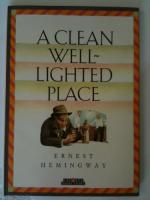|
This section contains 3,319 words (approx. 12 pages at 300 words per page) |

|
SOURCE: “Survival through Irony: Hemingway's ‘A Clean, Well-Lighted Place,’” in Studies in Short Fiction, Vol. XI, No. 2, Spring, 1974, pp. 181-87.
In the following essay, Benert explores Hemingway's use of imagery and characterization in “A Clean, Well-Lighted Place.”
“A Clean, Well-Lighted Place” has with justice been considered an archetypal Hemingway story, morally and aesthetically central to the Hemingway canon. But its crystalline structure and sparse diction have led many critics to judge the story itself a simple one, either about nothingness, “a little nada story,” or about the author's positive values, a story “lyric rather than dramatic.”1 I would like to suggest that it is in neither sense simple, but that the feelings and ideas which lie behind it are complex and are expressed dramatically, chiefly through the characterization of the older waiter. The latter is a man of enormous awareness continually torn between what might be called religious...
|
This section contains 3,319 words (approx. 12 pages at 300 words per page) |

|


